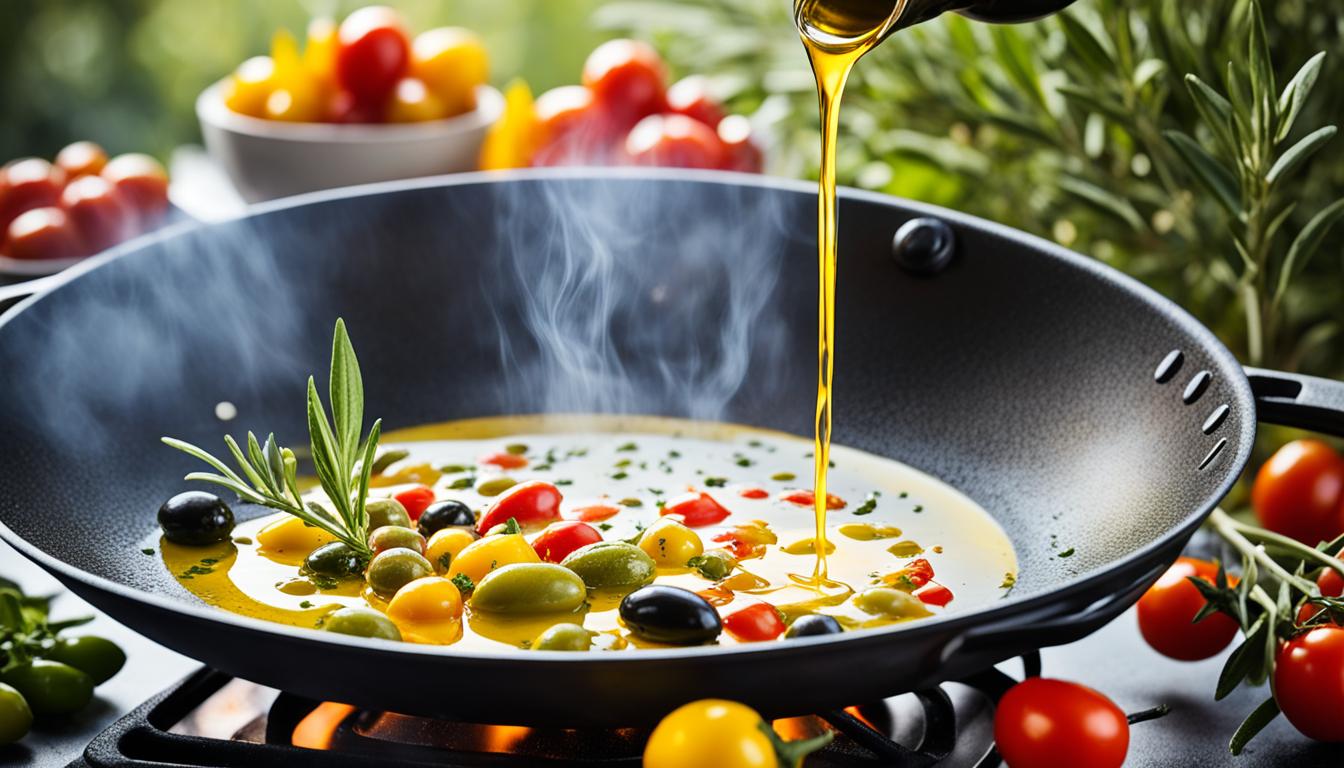When it comes to cooking with olive oil, we often hear a wide range of questions. Is olive oil safe to fry and sear with? Does it affect the flavor of dishes? In this article, we will address these common queries, providing you with valuable insights and tips for cooking with olive oil.
Is olive oil healthy for cooking?
Contrary to popular belief, cooking with olive oil at high heat is not as problematic as commonly believed. Scientific studies have shown that olive oil performs well under high-heat conditions and retains its nutritional properties. So, yes, olive oil is a healthy choice for cooking!
How does olive oil impact the flavor of dishes?
When deep frying, olive oil adds a distinct taste and enhances the flavors of the dish. However, when used for searing meats, it has a minimal effect on the overall flavor. So, whether you’re looking to infuse a rich Mediterranean taste or simply add a touch of healthy fat to your cooking, olive oil is a versatile option with great flavor benefits.
Throughout this article, we will delve deeper into the smoke point and oxidative stability of olive oil, providing you with a comprehensive understanding of its cooking properties. We will also share practical tips on how to choose the right olive oil for different cooking methods and reveal the benefits it offers for baking.
Now, let’s explore the fascinating world of olive oil cooking together!
Smoke Point and Oxidative Stability of Olive Oil
When it comes to cooking with olive oil, understanding its smoke point and oxidative stability is essential. The smoke point refers to the temperature at which the oil starts to smoke, indicating that it is being overheated. Extra virgin olive oil, a popular choice for cooking, has a smoke point ranging between 374 and 405 degrees Fahrenheit (190 to 207 degrees Celsius).
While the smoke point is often a concern for some, it’s important to note that olive oil’s oxidative stability is of greater significance. The oxidative stability determines how well the oil fats resist reacting when exposed to heat, oxygen, and light. Thanks to its richness in monounsaturated fats and antioxidants, extra virgin olive oil exhibits good oxidative stability. This means that it retains its health benefits and doesn’t significantly degrade when used for cooking.
It’s important to mention that there are different types of olive oil available on the market. These include extra virgin, virgin, pure, and light olive oil. Among these options, extra virgin olive oil stands out as the least processed and most flavorful choice, making it ideal for cooking.
As shown in the image above, olive oil data, including smoke points and oxidative stability, can further guide your cooking choices. Knowing the specific characteristics of different types of olive oil can help you make informed decisions based on your preferences and cooking needs.
Tips for Cooking with Olive Oil and Baking
When cooking with olive oil, it is important to follow best practices to ensure optimal results. One of the key steps is heating the oil until it is shimmering, but not smoking. This indicates that the oil is hot enough for cooking without reaching its smoke point. By doing so, we can retain the flavor and nutritional benefits of the olive oil while avoiding any unwanted burnt taste.
Another helpful tip is to use a splatter guard when cooking with olive oil. This simple tool can prevent oil splatters, which can not only create a mess but also pose a safety hazard. By using a splatter guard, we can keep the cooking process clean and enjoyable.
In addition to cooking, olive oil can also be used for baking. Its natural richness and moisture-enhancing properties make it an excellent choice for creating moist and tender baked goods. Whether we’re making cakes, cookies, or bread, substituting olive oil for other fats can bring a delightful twist to our baked creations.
When it comes to deep-frying, it is wise to choose the right oil for the job. While olive oil can be used for shallow frying and sautéing, deep-frying requires a large amount of oil that may be wasted if using an expensive olive oil. In such cases, it is recommended to opt for a cheaper, neutral-tasting oil like grapeseed oil. This way, we can maintain the desired flavor without breaking the bank.
By understanding the different types of olive oil and their flavor profiles, we can make informed choices when cooking and baking. Extra virgin olive oil, with its robust flavor, is ideal for drizzling over salads or finishing dishes. On the other hand, a milder olive oil variant may be better suited for delicate flavors or recipes where the oil’s taste should not overpower other ingredients.
In summary, incorporating these tips into our cooking and baking routines can help us make the most of olive oil’s versatility and health benefits. By following best practices, we can achieve delicious results while ensuring a satisfying and enjoyable culinary experience.
